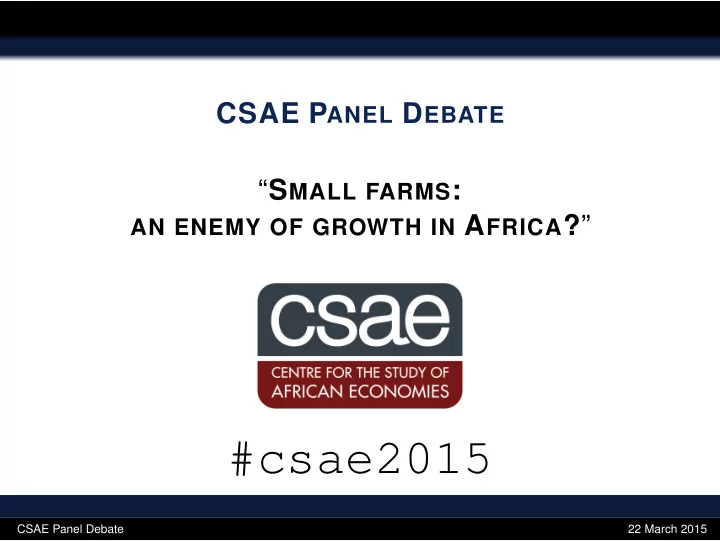

CSAE P ANEL D EBATE “ S MALL FARMS : AN ENEMY OF GROWTH IN A FRICA ? ” #csae2015 CSAE Panel Debate 22 March 2015
Awudu Abdulai University of Kiel Sam Benin CGIAR Doug Gollin University of Oxford Diego Restuccia University of Toronto CSAE Panel Debate 22 March 2015
Resource Allocation and Productivity in Agriculture Diego Restuccia University of Toronto CSAE Conference University of Oxford – March 2015 1/7
Average Farm Size across Countries 9 AUS 8 Corr = 0.61 7 Log of Average Farm Size ARG 6 CAN USA 5 PRY GBR BRA FIN 4 DNK LUX GER FRA IRL AUT COL 3 PER ESP PRI NLD BEL PAN ISR BHS CHE HND NOR PRT 2 ITA IRN WSM FJI TUR SVN GRC BFA PAK CYP THA 1 NAM KNA DMA UGA PHL LCA IND GIN LSO VCT BRB JPN GNB KOR 0 NPL IDN EGY ETH GRD MWI ZAR VNM −1 6 6.5 7 7.5 8 8.5 9 9.5 10 10.5 Log of 1990 Real GDP per Capita ◮ Adamopoulos and Restuccia (AER, 2014) “The Size Distribution of Farms...” 2/7
Land Quality across Countries Table: Production by Potential Yield (Counterfactual GAEZ Data) All Crops ( country obs. = 162) Actual Yield Potential Yield Yield Gap Rich 10% 739.5 1,220.0 1.65 Poor 10% 235.5 1,160.6 4.93 Ratio 3.14 1.05 1/2.99 ◮ Adamopoulos and Restuccia (2015) “Geography and Agricultural Productivity...” 3/7
Land Size by Farm TFP: Malawi ◮ Restuccia and Santaeulalia-Llopis (2015) “Land Misallocation and Productivity” 4/7
Land Productivity (Yield) by Farm TFP: Malawi 5/7
Yield by Farm Size: Malawi 6/7
Implications of Resource Misallocation ◮ Increase in agricultural TFP: 3.6-fold (output loss .28) ◮ Reduce inequality and poverty Farm Income Q1 Q5 Ratio Actual .14 4.8 34.1 Efficient 4.3 14.7 3.4 Ratio 30.6 3.1 – ◮ Structural change Actual Reallocation TFP a 1.0 3.6 0.65 0.04 N a Yield 1.0 1.0 Y a / N a 1.0 16.2 AFS 1.0 16.6 ◮ Broader impacts with endogenous investments by farmers, mechanization, selection in ability across sectors 7/7
#csae2015 CSAE Panel Debate 22 March 2015
Farm Size and the Future of African Agriculture Douglas Gollin Oxford Department of International Development CSAE Conference 22 March 2015 D. Gollin (2015) Farm Size CSAE Conference 1 / 6
Background Questions African farms are not uniquely small... ◮ Most of the world’s farms are small, including in the U.S. and Europe. Partly reflects advantages of family management and own-account labour. Also reflects systems of subsidy, policy, tax advantages, and other distortions. Definitions are also elusive... ◮ What is a farm? ◮ How do we measure size? (Area? Value of output? Employment?) D. Gollin (2015) Farm Size CSAE Conference 2 / 6
More Conceptual Questions Should we care about the size of the plot? The size of the land holding (i.e., ownership)? The management scale of the farm? Something else? = ⇒ Not always clear what we should be measuring! D. Gollin (2015) Farm Size CSAE Conference 3 / 6
US and EU Data on Farm Size US data are heavily skewed: ◮ One farm in five actually had less than $1,000 in sales ◮ Smallest 75% of US farms accounted for < 6% of gross sales, ≈ 25% of farmed area ◮ Largest 10% of farms accounted for > 75% of gross sales, > 40% of farmed area Similarly, in the EU, there are large numbers of smallholdings. ◮ For EU-27, tiny holdings ESU accounted for 47% of the “holdings,” 39% of the “regular farm workers” and 23% of the total farm work. But... only 7% of the UAA (farmed area), 2.5% of the total LSU ( ≈ livestock) and 1.6% of the SGM ( ≈ gross value). D. Gollin (2015) Farm Size CSAE Conference 4 / 6
US Cropland Distribution D. Gollin (2015) Farm Size CSAE Conference 5 / 6
Reframing the question? The point is perhaps not that Africa’s smallholders need to disappear, but that there needs to be space for a large-farm (and probably large family farm) sector to emerge. What are the obstacles and opportunities? ◮ Barriers to consolidation... ◮ Availability of non-farm employment... ◮ Limited domestic markets for agricultural output; weak access to growing urban demand... Some changes are likely to occur organically; others may require changes in policies. Not helpful (and perhaps not realistic) to insist that development policies should only target smallholders. What kind of large farms are competitive? What mechanisms will lead to their emergence? D. Gollin (2015) Farm Size CSAE Conference 6 / 6
#csae2015 CSAE Panel Debate 22 March 2015
“ If, over the next half-century, Africa were to converge on the performance of much of the rest of the developing world both in growth and in poverty reduction, what would be the defining features of the organization of its agriculture in 2060? ” Collier and Dercon (2014) CSAE Panel Debate 22 March 2015
“ The value of output per worker in nonagriculture still appears to be roughly twice as high as in agriculture in the typical country, and even higher in the typical developing countries. The implication is that there should be large income gains from workers moving out of agriculture and into other economic activities . ” Gollin, Lagarkos and Waugh (2014) CSAE Panel Debate 22 March 2015
Foster and Rosenzweig (2011) CSAE Panel Debate 22 March 2015
CSAE Panel Debate 22 March 2015
Deininger et al (2011) CSAE Panel Debate 22 March 2015
Hsieh and Olken (2014) CSAE Panel Debate 22 March 2015
#csae2015 CSAE Panel Debate 22 March 2015
Recommend
More recommend